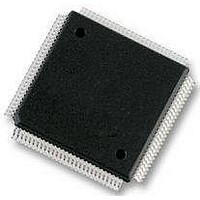MC912D60CCPVE Freescale Semiconductor, MC912D60CCPVE Datasheet - Page 309

MC912D60CCPVE
Manufacturer Part Number
MC912D60CCPVE
Description
IC MCU 16BIT 112-LQFP
Manufacturer
Freescale Semiconductor
Series
HC12r
Datasheet
1.MC912D60ACFUE8.pdf
(460 pages)
Specifications of MC912D60CCPVE
Core Processor
CPU12
Core Size
16-Bit
Speed
8MHz
Connectivity
CAN, MI Bus, SCI, SPI
Peripherals
POR, PWM, WDT
Number Of I /o
68
Program Memory Size
60KB (60K x 8)
Program Memory Type
FLASH
Eeprom Size
1K x 8
Ram Size
2K x 8
Voltage - Supply (vcc/vdd)
4.5 V ~ 5.5 V
Data Converters
A/D 16x8/10b
Oscillator Type
Internal
Operating Temperature
-40°C ~ 85°C
Package / Case
112-LQFP
Processor Series
HC912D
Core
HC12
Data Bus Width
16 bit
Data Ram Size
2 KB
Interface Type
CAN, SCI, SPI
Maximum Clock Frequency
8 MHz
Number Of Programmable I/os
86
Maximum Operating Temperature
+ 85 C
Mounting Style
SMD/SMT
3rd Party Development Tools
EWHCS12
Minimum Operating Temperature
- 40 C
On-chip Adc
10 bit, 8 Channel
Lead Free Status / RoHS Status
Lead free / RoHS Compliant
Available stocks
Company
Part Number
Manufacturer
Quantity
Price
Company:
Part Number:
MC912D60CCPVE
Manufacturer:
FREESCAL
Quantity:
203
Company:
Part Number:
MC912D60CCPVE
Manufacturer:
Freescale Semiconductor
Quantity:
10 000
- Current page: 309 of 460
- Download datasheet (5Mb)
17.4.3 Transmit Structures
MC68HC912D60A — Rev. 3.1
Freescale Semiconductor
An overrun condition occurs when both the foreground and the
background receive message buffers are filled with correctly received
messages with accepted identifiers and another message is correctly
received from the bus with an accepted identifier. The latter message is
discarded and an error interrupt with overrun indication is generated if
enabled. The msCAN12 is still able to transmit messages with both
receive message buffers filled, but all incoming messages are
discarded.
The msCAN12 has a triple transmit buffer scheme in order to allow
multiple messages to be set up in advance and to achieve an optimized
real-time performance. The three buffers are arranged as shown in
Figure
All three buffers have a 13 byte data structure similar to the outline of the
receive buffers (see
additional transmit buffer priority register (TBPR) contains an 8-bit so
called local priority field (PRIO) (see
(TBPR)).
In order to transmit a message, the CPU12 has to identify an available
transmit buffer which is indicated by a set transmit buffer empty (TXE)
flag in the msCAN12 transmitter flag register (CTFLG) (see
Transmitter Flag Register
The CPU12 then stores the identifier, the control bits and the data
content into one of the transmit buffers. Finally, the buffer has to be
flagged as being ready for transmission by clearing the TXE flag.
The msCAN12 will then schedule the message for transmission and will
signal the successful transmission of the buffer by setting the TXE flag.
A transmit interrupt will be emitted
used to drive the application software to re-load the buffer.
1. The transmit interrupt is generated only if not masked. A polling scheme can be applied on
TXE also.
17-2.
MSCAN Controller
Programmer’s Model of Message
(CTFLG)).
(1)
Transmit Buffer Priority Registers
when TXE is set and this can be
Storage). An
MSCAN Controller
Message Storage
Technical Data
msCAN12
309
Related parts for MC912D60CCPVE
Image
Part Number
Description
Manufacturer
Datasheet
Request
R
Part Number:
Description:
Manufacturer:
Freescale Semiconductor, Inc
Datasheet:
Part Number:
Description:
Manufacturer:
Freescale Semiconductor, Inc
Datasheet:
Part Number:
Description:
Manufacturer:
Freescale Semiconductor, Inc
Datasheet:
Part Number:
Description:
Manufacturer:
Freescale Semiconductor, Inc
Datasheet:
Part Number:
Description:
Manufacturer:
Freescale Semiconductor, Inc
Datasheet:
Part Number:
Description:
Manufacturer:
Freescale Semiconductor, Inc
Datasheet:
Part Number:
Description:
Manufacturer:
Freescale Semiconductor, Inc
Datasheet:
Part Number:
Description:
Manufacturer:
Freescale Semiconductor, Inc
Datasheet:
Part Number:
Description:
Manufacturer:
Freescale Semiconductor, Inc
Datasheet:
Part Number:
Description:
Manufacturer:
Freescale Semiconductor, Inc
Datasheet:
Part Number:
Description:
Manufacturer:
Freescale Semiconductor, Inc
Datasheet:
Part Number:
Description:
Manufacturer:
Freescale Semiconductor, Inc
Datasheet:
Part Number:
Description:
Manufacturer:
Freescale Semiconductor, Inc
Datasheet:
Part Number:
Description:
Manufacturer:
Freescale Semiconductor, Inc
Datasheet:
Part Number:
Description:
Manufacturer:
Freescale Semiconductor, Inc
Datasheet:











